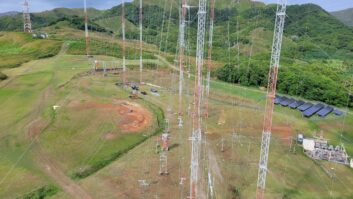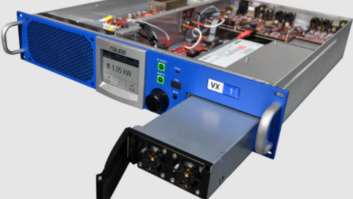(click thumbnail)The Conrad Garage in 1920Storage Looms for the Site of Radio’s First Commercial Broadcasts From ‘Amateur’ Station 8XK.
The year was 1916. In a little brick garage in suburban Pittsburgh, an engineer toiled away on secret electrical experiments. The neighbors might not have understood what Dr. Frank Conrad was up to, but his tinkering led to the first commercial radio broadcast in this country.
Conrad’s success with experimental station 8XK encouraged him to push his employer, Westinghouse Electric and Manufacturing Company, to build its own commercial station, KDKA.
But unlike other sites where great American inventors launched industries of enormous wealth and cultural impact, such as the Edison Museum in West Orange, N.J., and the Henry Ford Museum in Dearborn, Mich., this 80-year-old historic site is in danger of being lost forever.
The property on which the Conrad house and garage sit has been sold and the site slated for redevelopment. Disassembly of the garage began in late March, with plans to reconstruct it later brick by brick, when its champions raise the funds.
Birthplace of radio
Rick Harris is chairman of the Frank Conrad Garage Project, an eleventh-hour effort to save the birthplace of radio and make it the centerpiece of a proposed National Museum of Broadcasting in Pittsburgh.
With a little help from Interep Chairman Ralph Guild and Save America’s Treasures, a public-private partnership between the White House Millennium Council and the National Trust for Historic Preservation, this effort might prove successful.
“It was slated to be destroyed as early as May 1, 2001,” said Harris, “to make way for a fast-food restaurant.”
While the story of radio is dotted with colorful characters like Reginald Fessenden, Major Edwin H. Armstrong and Vladimir Zworykin, Frank Conrad was a visionary who took a simple “wireless” invention and built it into a practical product which some would say kicked off the commercial radio industry.
The book “Early Radio in the USA: The Story of Westinghouse Electric” by George H. Douglas provides some context for Conrad’s achievement.
For the most part, Douglas writes, even as late as 1920, almost 20 years after Marconi first demonstrated the “wireless telegraph,” only a few amateur hobbyists had radio sets that they had built themselves.
Early years
Few could see the commercial value in wireless communications. Radio reception was still erratic and the public couldn’t buy ready-made sets until 1920. Westinghouse was one of the first companies to make these new receivers available and so had a vested interest in providing the content.
Frank Conrad was a Westinghouse engineer in charge of the company’s radio division that worked on government contracts, developing radio technology for the military during World War I.
During the war, Conrad developed radio technology that enabled pilots to send voice messages from airplanes to the ground.
And after the war, Conrad spent time experimenting in his garage just outside of Pittsburgh with his own experimental radio station, 8XK, which was licensed by the U.S. Commerce Dept. as an “amateur” station.
He and his two sons aired songs played live by local musicians and singers and broadcast phonograph records. The few people with radios, or homemade “crystal radio” sets, started to tell their neighbors. Then Conrad began to receive a deluge of calls and letters from people requesting that he play a special song dedicated to someone at a specific time, according to Rick Harris.
“He got hundreds of requests each week,” Harris said. “Average people just couldn’t believe that you could play music over the radio.”
When he started to borrow records from the local Hamilton Music Store, Conrad began to credit the music store on the air and thus what many believe was the first commercial broadcast was made from that garage outside Pittsburgh in 1920.
Also that year, the public’s interest in Conrad’s “programs” spurred a local department store to advertise an amateur radio set for about $10. That same year, at Conrad’s urging, Westinghouse built a 100-watt transmitter that Conrad designed and tested. Just in time for the 1920 presidential election results, the U.S. Department of Commerce, the agency first charged with regulating radio, licensed commercial station KDKA.
“The license wasn’t official until you had it in your hands and so the Cox-Harding elections returns were broadcast on ‘8ZZ,’ which became KDKA two days later when the U.S. Post Office delivered the commercial license that Westinghouse had applied for,” Harris said.
In 1937, when pioneer Marconi died, all the radio stations in the world broadcast a two-minute silence; when Conrad died at age 67 in 1941, there was no such fanfare.
Money talks
At press time, Harris was disassembling the garage and moving it into storage. Now he and the garage project will need to find additional funding to rebuild the garage or build the proposed museum.
The largest grant the project has received thus far is $50,000 from New York-based Interep Chairman Ralph Guild.
“I have a very strong interest in this project because it’s a link to the very beginning of the medium,” said Guild. “Rick (Harris) and his associates are very dedicated.”
While Guild’s firm, Interep, has a commercial relationship with KDKA(AM) and its current owner, Infinity Broadcasting, the money donated to save the garage was from Guild’s personal funds.
Michael Young, general manager of KDKA, said his station has no local dollars available to contribute.
“Our parent company has a foundation that gets involved in any contributions the company makes, but we can’t do it at the station level.”
Respect
Young said KDKA has been generous with its free airtime and other in-kind services for the cause.
“We have a lot of respect for what Mr. Harris is trying to do and we’ve done everything we can to help raise awareness,” said Young.
Harris said, “That is all true, but the bottom line is that neither KDKA, the CBS Foundation, Infinity nor Viacom has given us any money. When we solicit other organizations for funds, we’re always asked how much KDKA has contributed, but when we tell them we received no money from them, that usually ends the conversation.”
While there was some early talk that the CBS Foundation would make a cash donation, in a letter last November Harris received the official word.
“CBS said they would not be able to contribute to the Conrad Garage Project,” said Harris. “I assume this means that the $5,000 they pledged earlier will not be forthcoming.”
Dana McClintock, vice president communications for CBS/Infinity, declined to comment, other than to say that the CBS Foundation was closed as part of the recent mergers and reorganization. The NAB declined to comment on the project.
Alice Sapienza Donnelly, author of “When Radio Was Young” and passionate advocate of the garage project, said the group has asked many broadcasters and potential donors for help with the garage project and the proposed museum that would house it. She said the situation is exasperating.
“The Conrad Garage is the Bethlehem of broadcasting – there is no room at the inn in this situation,” Sapienza Donnelly said, in reference to the group’s frustration in trying to find a site to rebuild their treasure.
Harris said one potential tract of land, a former KDKA transmitter site, is ideal for the proposed museum where the deconstructed garage could be resurrected. It is four miles from the original Conrad property.
While it appears that Harris may have been quick enough to spare the garage from demolition, he said he will need at least another $250,000 to rebuild and restore the facility.
The spark
Harris has no background in radio, but got excited about the world of broadcasting at age six.
“The building where Conrad did his experiments later became an Elks lodge that my dad and grandfather belonged to,” said Harris. “I remember when I was very young I attended a Christmas party there and my grandfather showed me around the building and said, ‘This is where radio started.’ That stuck with me all these years.”
Harris is an unpaid volunteer in his capacity with the Conrad Project and has spent $75,000 of his own funds to help keep the organization alive.
“I am also president of a small graphics firm, R.J. Harris Company, which I’ve put on hold while we were in this crisis,” said Harris. “I’ll need to get back to that soon, though.”
Those interested in the “Save the Conrad Garage” effort can visit http://trfn.clpgh.org/nmb or contact Rick Harris in Pittsburgh at (412) 241-4508. The National Museum of Broadcasting and The Frank Conrad Garage Project are nonprofit organizations.













